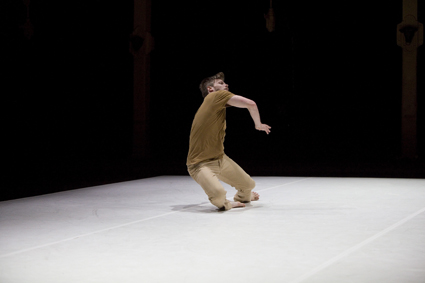 |
Alisdair Macindoe, Dual photo Ponch Hawkes |
These developments haven’t been sudden nor have they been solely of a kind felt by dance. The emergence of contemporary performance of the 1970s and 80s signalled the fruitful bringing together of hitherto largely discrete forms. Here, movement played a significant role, texts were projected or intoned, conventional playwriting eschewed, design was no longer background or setting but a creation in itself, sound was no longer played in the intervals between words, and the application of new technologies could find room to move. Dance, more than theatre ever has, embodied or took on this opening out and became a leader in exploring the potential of digital technologies in the late 90s into the 2000s.
This process of hybridisation is still playing out, not so much creating new forms as mutating existing ones: a dance work is still a dance work but the manner of its framing and the ways in which it engages its audiences are changing, offering experiential intensity. We can still witness the movement of Russell Dumas’ dancers as simply dance in and of itself, without a sound score or elaborate costuming and lighting. Some works indicate a focus on the dancer’s movements with aural close-ups, amplifying the sounds made by the breathing, stressed body or its impact on surfaces. These and other works play with our senses and heighten the sense of immersive proximity.
The programming of Dance Massive 2013, a small but telling slice of Australian dance, has revealed that contemporary dance is as engaged as ever with the nature of the theatrical experience, pushing further and further into immersion, perceptual play and the production as performative installation.
installed
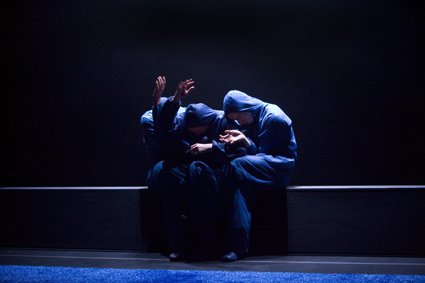 |
More or Less Concrete, Tim Darbyshire photo Ponch Hawkes |
Sounds actual, amplified and treated made by dancers in More or Less Concrete and Physical Fractals filled the aural space about us, as did sounds of popping smoke-ring machines in Life Support with increasing intensity as smoke filled a diminishing auditorium. In More or Less Concrete the miked breathing, coughing, gasping and thumping of performers’ bodies mutated from the real into surreal soundscapes for its headphoned audience. In Physical Fractals, framed with light, four pairs of microphones angled close to the floor set the physical and aural parameters of the dance with the speed, beat and bounce of the taut choreography. Two microphones are swung over our heads mid-show, making us, and the very air around us, part of an installation. In Dual the rectangle on which the dance unfolds is just one plane of an aural space in which sounds that sweep by and at us, and we hear three variations of the score, making the space at once aurally familiar and strange (in its permutations).
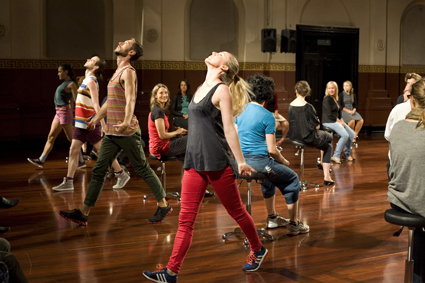 |
P.O.V, Lee Serle photo Ponch Hawkes |
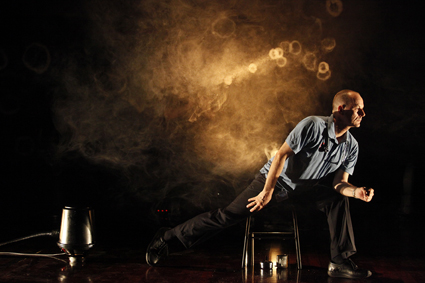 |
Tony Osborne, Life Support, Ashley Dyer photo Rachel Roberts |
Black Project 1 is not simply danced, it is installation-cum-dance. It has the powerful appeal of experiencing visual art in the making as two strange graffiti-ists strip a wall to make large scale patterns of white against sombre shades of black and the sheen of the makers’ charcoal skins.
sensed
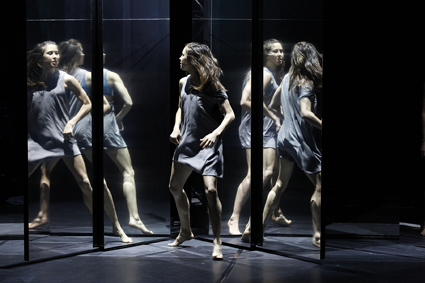 |
Lauren Langlois, 247 days, Chunky Move photo Jeff Busby |
The design for 247 Days is a curved wall of mirrors that reflects, multipliesand even disappears the dancers. The wall opens to form doors and more reflections, providing sensory pleasures and thematic complexity. No mere background, this vast mirror is integrated with the dancing and is operated by the performers.
Choreographers happily, and meaningfully, played with our perceptions in this Dance Massive. In extreme cases our visual field was limited by low lighting levels such that we often had to adjust to make sense of what we were seeing. Correlative or contrasting movement is as important as light in these works: the alternation of stillness and rapid movement in Black Project 1; the sheer slowness and odd body shapings in More or Less Concrete; the brush strokes of movement in moments of ultra-low light in Physical Fractals.
Matthew Day’s Intermission offers a very special kind of immersion, our attention locked in synch with the waves of vibration that consume the dancer’s body while our ears buzz and hum with the broad counterpoint provided by James Brown’s score. Our appreciation of Day’s movement is an extension of what we feel for any dancer who engages us, but the minimalist repetition and variation make for a distinctively intense experience.
hybridised
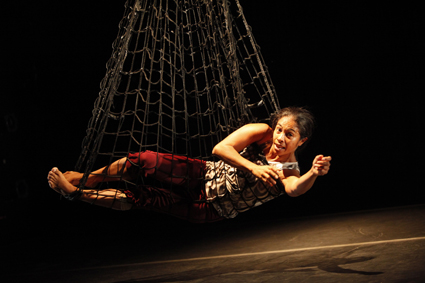 |
Dalisa Pigram, Gudirr Gudirr, Marrugeku photo Ponch Hawkes |
Skeleton is the creation of a choreographer, Larissa McGowan, working with a theatre director, Sam Haren. Lo-tech stage wizardry and high-speed dance generate a world of brutal ephemerality where accidents and nostalgia uncomfortably co-exist. Skeleton’s constant choreographic content and pulse prevents it from being labelled dance theatre, but it does have a clarity of purpose and design, not least in it use of objects (skateboard, BMX bike, headphones, baseball bat) that incline it to that form without disadvantage and with increased thematic coherence (although my fellow writer Carl Nilsson-Polias thought the work underdeveloped). Jo Lloyd’s Future Perfect has some kinship with Skeleton’s structural-thematic approach: it too deploys propulsive, finely realised choreography and ends in dissolution.
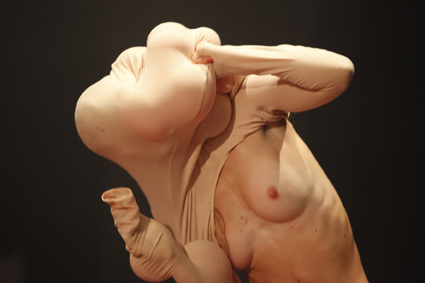 |
Atlanta Eke, Monster Body photo Rachel Roberts |
Some of the show’s images are overwrought—the cute animal-headed figure posing sexily to the repeated roar of a motorcycle promptly empties itself of significance—or too awkwardly realised—when Eke fills her rubber body suit with water-filled balloons to become multi-breasted the image is muddled. These contrast with scenes more adroitly and powerfully realised, including Monster Body’s most potent image—the naked Eke growling and howling with superb vocal control while executing precise dance steps. Nothing else in the performance was a strange or monstrous as this.
futured
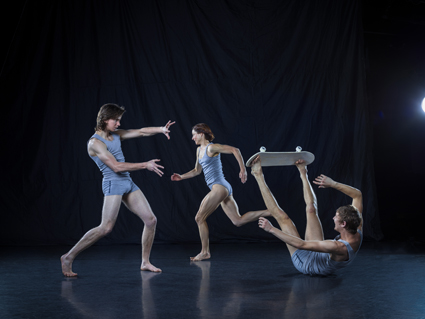 |
Tobiah Booth-Remmers, Lisa Griffiths, Lewis Rankin, Skeleton photo Chris Herzfeld, Camlight Productions |
questioned
There are questions to be asked, for example about a certain sameness among space-eating sound scores, however dextrously and ingeniously they have been realised (see Gail Priest’s overview). As well, there’s the dance language itself, dominated by hyper-fluency and style melding that allows little time or space for reflective movement with only a few exceptions. Antony Hamilton, Jo Lloyd, Stephanie Lake, Anouk van Dijk and Natalie Abbotts’ hyperactive subjects contrast sharply with Dumas’ and Darbyshire’s slowly evolving formations, while Matthew Day hovers between, moving in grand slow arcs while vibrating at speed. This is not deny the rich diversity of choreographic approaches in the first group and the intricacies realised by their skilful dancers. As for ideas, Dance Massive was full of them, from the overtly political and cultural to speculations on ritual and worship, art-making, accidents, the self, relationships, mutability, the city and the future.
Dance Massive once again proved a deeply satisfying experience for audiences and for bringing together many of the dance community. As for its other function, the selling of Australian work to overseas presenters, outcomes are as yet unknown although there were some promising signs.
Now that Spring Dance has been dropped by the Sydney Opera House, Dance Massive is the only substantial dance event for what are for the most part independent Australian contemporary dance makers, although it’s hoped that the MoveMe Dance Festival (see review) presented by STRUT and Ausdance WA in Perth might grow in scale and reach to bolster national dance culture. (It would be misleading to suggest that Spring Dance did a great deal for Australian dance, but it did develop an audience—but apparently not a big enough one despite press release rhetoric about record attendance numbers.) I hope that Dance Massive, with its doubtless limited resources but committed host venues, can continue to offer artists and audiences the opportunity to see and celebrate significant work, especially from the kind of emerging talent on show this year. It would be even more satisfying if more interstate artists could become part of Dance Massive (the numbers have varied event to event and there are many variables involved, cost not the least among them). The need for Dance Massive is great; long may it prosper in an era of increasing ephemerality.
Arts House, Dance House, Malthouse, Dance Massive 2013, Melbourne, March 12-24
© Keith Gallasch; for permission to reproduce apply to [email protected]








 back
back